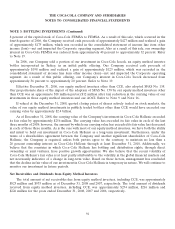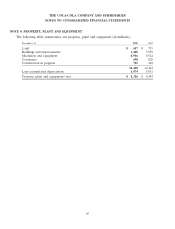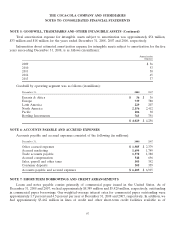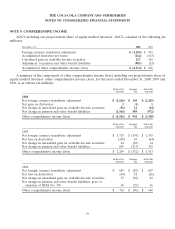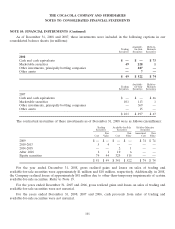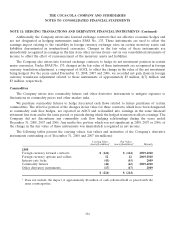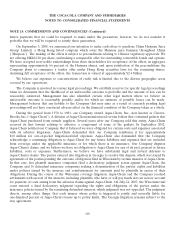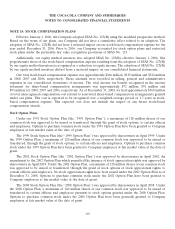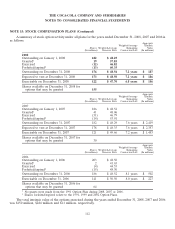Coca Cola 2008 Annual Report Download - page 105
Download and view the complete annual report
Please find page 105 of the 2008 Coca Cola annual report below. You can navigate through the pages in the report by either clicking on the pages listed below, or by using the keyword search tool below to find specific information within the annual report.THE COCA-COLA COMPANY AND SUBSIDIARIES
NOTES TO CONSOLIDATED FINANCIAL STATEMENTS
NOTE 11: HEDGING TRANSACTIONS AND DERIVATIVE FINANCIAL INSTRUMENTS (Continued)
Our Company recognizes all derivative instruments as either assets or liabilities in our consolidated balance
sheets at fair value. The accounting for changes in fair value of a derivative instrument depends on whether it
has been designated and qualifies as part of a hedging relationship and, further, on the type of hedging
relationship. At the inception of the hedging relationship, the Company must designate the instrument as a fair
value hedge, a cash flow hedge, or a hedge of a net investment in a foreign operation. This designation is based
upon the exposure being hedged.
We have established strict counterparty credit guidelines and enter into transactions only with financial
institutions of investment grade or better. We monitor counterparty exposures daily and review any downgrade
in credit rating immediately. If a downgrade in the credit rating of a counterparty were to occur, we have
provisions requiring collateral in the form of U.S. government securities for substantially all of our transactions.
To mitigate presettlement risk, minimum credit standards become more stringent as the duration of the
derivative financial instrument increases. To minimize the concentration of credit risk, we enter into derivative
transactions with a portfolio of financial institutions. The Company has master netting agreements with most of
the financial institutions that are counterparties to the derivative instruments. These agreements allow for the
net settlement of assets and liabilities arising from different transactions with the same counterparty. Based on
these factors, we consider the risk of counterparty default to be minimal.
Interest Rate Management
Our Company monitors our mix of fixed-rate and variable-rate debt as well as our mix of short-term debt
versus long-term debt. This monitoring includes a review of business and other financial risks. From time to
time, in anticipation of future debt issuances, we may manage our risk to interest rate fluctuations through the
use of derivative financial instruments. During 2008, the Company discontinued a cash flow hedging relationship
on interest rate locks, as it was no longer probable that we would issue the long-term debt for which these
hedges were designated. As a result, the Company reclassified a previously unrecognized gain of approximately
$17 million from AOCI to earnings as a reduction to interest expense. Additionally, during 2008 the Company
recognized losses of approximately $9 million related to the portion of cash flow hedges deemed to be ineffective
as an increase to interest expense.
Any ineffective portion, which was not significant, of these instruments during 2007 and 2006 was
immediately recognized in net income.
Foreign Currency Management
The purpose of our foreign currency hedging activities is to reduce the risk that our eventual U.S. dollar net
cash inflows resulting from sales outside the United States will be adversely affected by changes in foreign
currency exchange rates.
We enter into forward exchange contracts and purchase foreign currency options (principally euro and
Japanese yen) and collars to hedge certain portions of forecasted cash flows denominated in foreign currencies.
The effective portion of the changes in fair value for these contracts, which have been designated as foreign
currency cash flow hedges, was reported in AOCI and reclassified into earnings in the same financial statement
line item and in the same period or periods during which the hedged transaction affects earnings. The Company
did not discontinue any foreign currency cash flow hedging relationships during the years ended December 31,
2008, 2007 and 2006. Any ineffective portion, which was not significant in 2008, 2007 or 2006, of the change in
the fair value of these instruments was immediately recognized in net income.
103



